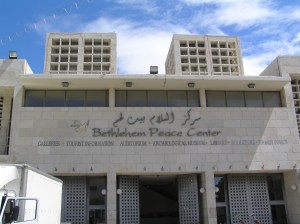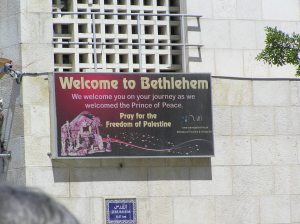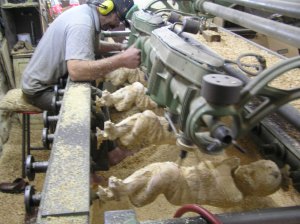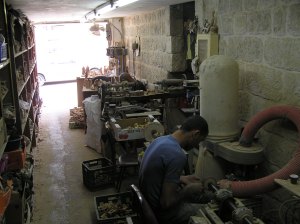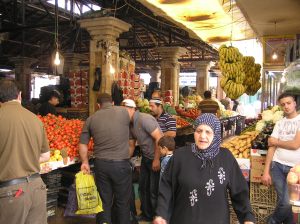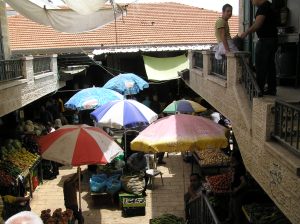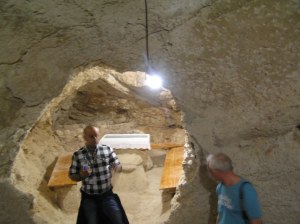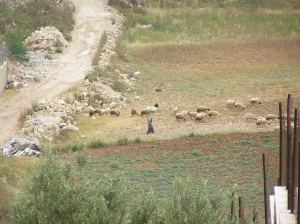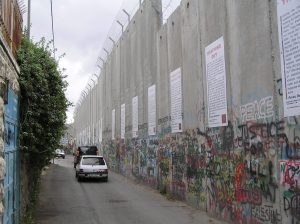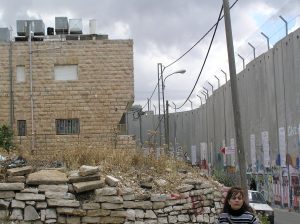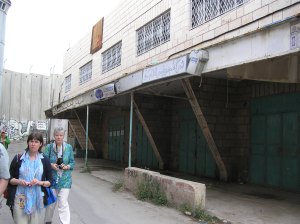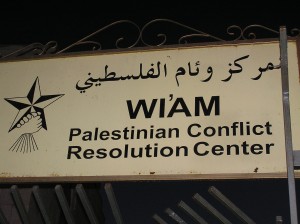We thought we might be able to get our breath back a bit the next day but no chance! Breakfast at 8 and on the bus by 9.
Today was the 15th May – the day on which Palestinians remember Al Nakba or “The Catastrophe”. This was the day when Palestinians began to be forcibly removed from their land and homes following the establishment of the state of Israel. We were pleased and excited to be here to show our support on this day. Our guides kept a watchful eye and warned us that we might need to move quickly if anything kicked off but there were no problems.
First stop of the day was the offices of the Holy Land Trust in Bethlehem:
Our speaker was Elias who spent his school years under the Israeli military rule. He told us that at school all teaching materials were Israeli and that Palestine was not mentioned. His only experience of Israelis’ was military.
Elias told us that the first initfada 1987-92 was largely non-violent and it led to the 1991 Oslo agreement which saw the establishment of the land disvisions A, B and C and the Palestinian authority take control of A and partly B with Israel in control of C. This was to be an interim arrangement for 5 years only with control gradually being transferred to the Palestinian authority. This did not happen however and growing frustrations led to the second intifada in 2000. This was a much more bloody afair and led to a greater level of military occupation.
The Holy Land trust was started by SA. He is a Palestinian Christian whose family were refugees from Jerusalem. His uncle was deported to the US and S did a degree in the US in conflict resolution. When he returned home he wondered how the occupation could be ended and his answer was to start an organisation to promote non-violence. The Holy Land Trust now train others in non-violent methods.
In 2007 they ran the first non-violent demonstration and now hundreds of people take part in non-violent demonstrations in the West Bank.
The Trust identified that there would be several challenges for the Palestinians should there be an end to the occupation:
First are Palestinians ready to form a Palestinian state? – the answer seemed to be no, so they began a leadership training programme for people entering leadership roles such as the Police, the Palestinian Authority etc. Leadership courses are for men and women – with emphasis on women since it is thought that they may be more successful in resolving the conflict!
Secondly, Palestinians feel that they need to be more connected with the international community and so the HLT started a media centre which includes an online news agency in English, Arabic, French and German. The aim is to report first hand stories and to focus on non-violence because such stories rarely feature on main stream news channels such as sky, fox etc. The main channels tend to only concentrate on the violent clashes and do not show the other side. This gives a skewed perspective suggesting that violence is more common than it actually is. (We saw none in our time even during the demonstrations on the Nakba and never once felt unsafe. In fact I felt safer there than I often do in the centre of Bristol!).
The online Palestinian news channel is:
They try to create bridges between the local and international communities through establishing a travel department to enable people to visit the “Living stones” and not just the dead ones – ie not just the standard tourist sites. The aim is to have no bias towards either Palestinian or Israeli but for the bias to be towards peace and justice.
A programme for International students enable them to come and study languages, history and to take part in volunteer projects and learn Palestinian culture.
Elias is not able to travel freely and like most Palestinians he has to get a permit to enter Jerusalem and this is only granted for special occasions such at Christmas and Easter. Groups which travel to Jerusalem have to go with one of the 43 authorised tour guides or with an Israeli guide. Although Elias has qualified as a tour guide, Israel will no longer issue authorisations for Palestinian guides to enter Jerusalem and a court case at present is attemptiong to withdraw that permission from the existing guides. This would mean that only Israeli guides would be able operate outside of the West Bank.
In area C there are many issues of home demolition. In Israel military law and civil law are different. A project exists to rebuild homes that have been demolished in a non-violent message which says “we intend to stay here”. There is no restriction on building materials except in Gaza, but all imports are taxed by the Israelis. Thousands of homes in the West Bank have demolition orders placed on them by the Israeli authorities. Permission for building is usually gained from the local Palestinian council but Israel requires that a permit is also gained from the military authorities and these are not usually granted. This means that homes cannot be built to house growing families and populations. The natural expansion of Palestinian towns and villages is therefore prevented and this leaves a housing shortage, and overcrowding in existing homes. Many Palestinians therefore take a risk to build without a permit. Once a demolition order has been issued, the demolition may or may not take place in practice. However the family may be given less than 48 hours notice that they must either demolish their own home or allow the military to do it for them. Sometimes they are given less than 2 hours to remove their possessions. Often the demolitions take place early in the morning. If the house is demolished the family then receive a bill for the demolition. No compensation is paid and the family have to go and live with other family or friends adding to the overcrowding and the stress that this causes.
In East Jerusalem and in the C areas land is often confiscated without any compensation being paid.
Christian / Muslim relations in Palestine are very good. Religion is not usually an issue. (We found the Palestinian people, Christian and Muslim alike, friendly and hospitable and welcoming.)
Bethlehem Live:
http://vicbethlehem.wordpress.com/bet-lahem-live-2013/
An art and culture festival to revive the area and and promote Palestinian culture and produce. Tours of Bethlehem usually are limited to arriving at the Bus station going to the Church of the Nativity and back to the bus. Not many people stay in Bethlehem – they miss out on much! We stayed there for four days and enjoyed visiting the markets, the churches, the Bethlehem Peace Centre, the souvenir shops the Milk Grotto and even the shop at the top of Milk Grotto Street where you can see olive wood souvenirs and religious artefacts being made out of the local olive wood.
It is hoped that Bethlehem live will become an annual summer festival encouraging more tourists to visit and stay in the town.
After visiting the Holy Land Trust we were guided by R whose grand father had been a shepherd. We visited the church of the Nativity just off Manger Square – a site of pilgrimage for many Christians. We then traveled just out of Bethlehem to Beit Sahour – the Shepherds Field. This is where the Angels appeared to the shepherds announcing the birth of Jesus just up the road. There we enetered a cave which was just like one of thousands in the area where people lived and where animals were cared for. Thats why it is certain that Jesus was born in a cave type stable rather than in a victorian wooden job!
Our guide told us how his family lived in caves until 1948 which was normal.
We had lunch at Ruth’s Field Cafe which I can highly recommend.
In the afternoon we went back to Bethlehem and viewed the progress of the separation wall which separates Palestinian and Jewish communities. It is built down the middle of former main shopping streets and roads and encircles houses.
In the evening we were hosted at the Wi’Am conflict resolution centre:
Who offered us fantastic hospitality and a great meal!

